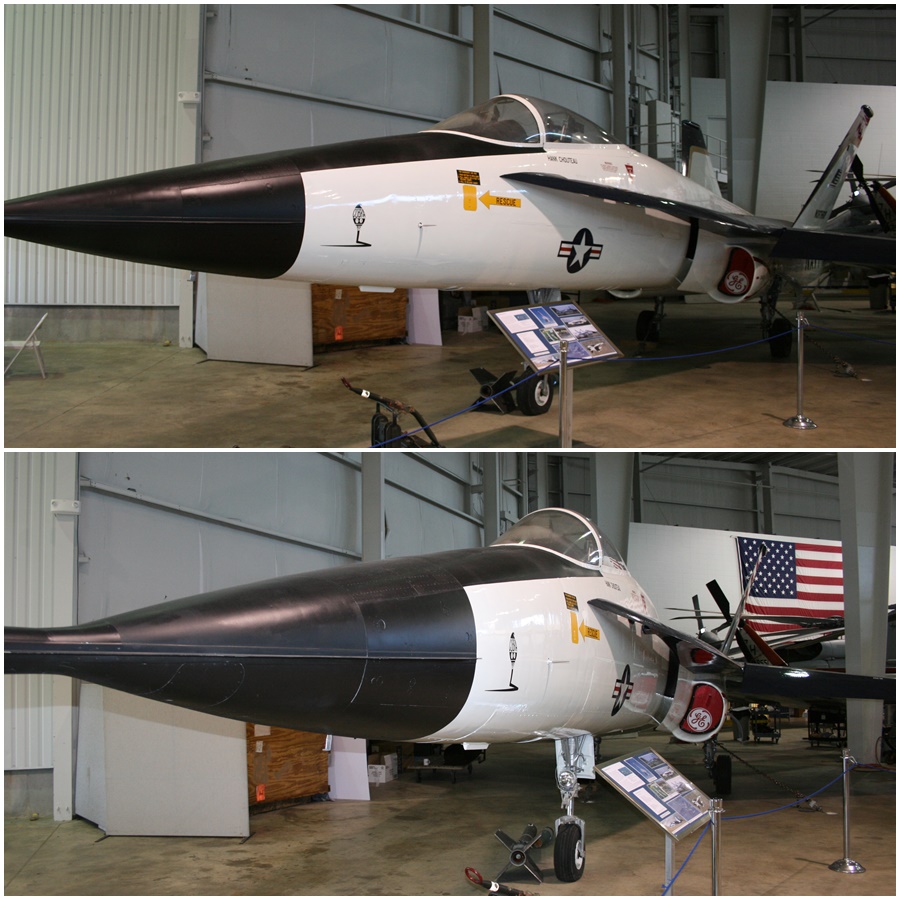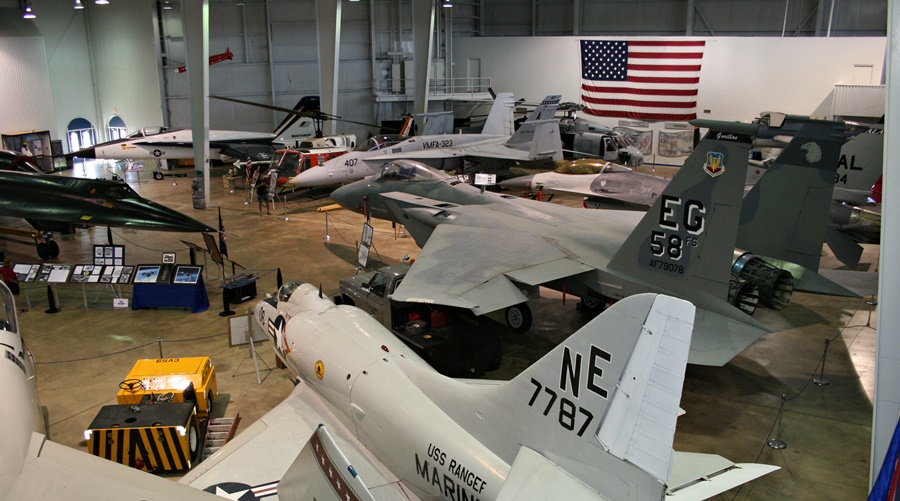In 1972 the USAF Lightweight Fighter (LWF) Program was launched to develop a smaller, highly maneuverable, lower cost air combat fighter to complement and conduct roles not suitable for the highly capable but expensive McDonnell Douglas F-15A Eagle air superiority fighter. This program ultimately pitted two contenders in a fly off, the General Dynamics YF-16 and Northrop YF-17 prototypes.

Only two YF-17 prototypes were built, with 72-1569 conducting its first flight on June 9th, 1974 at Edwards Air Force Base in California – test pilot Henry “Hank” Chouteau said “It’s a fighter pilot’s fighter“. On June 11th, 1974 prototype 72-1569 became the first aircraft from the United States to break the sound barrier achieving Mach 1.0 in level flight without the use of an afterburner. Prototype 72-1570 took flight on August 21st, 1974.
The YF-17 earned the unofficial nickname of “Cobra“ from the distinctive and new technological design wing leading-edge root extension (LERX), which resembled the cobra snakes hood (the YF-17 was developed from a late 1960’s Northrop concept fighter that was intended the replace the Northrop F-5 – firstly the P-530 Cobra multi-role fighter which then proceeded to the updated P-600 fighter, both of which had not received any domestic or international buyer interest. The power plant of the P-530 and advanced aerodynamic concepts of the P-600 were developed into the YF-17 prototype). The LERX design concept increased lift, enabling greater maneuverability at an angle of attack exceeding 50° and aided stability and spin resistance. The twin vertical tail design also provided flight performance advantages at a high angle of attack.
The YF-17 prototype featured both digital and analog mechanical flight control systems. These included a Control Augmentation System (CAS) that had both electronic and mechanical systems for pitch control, an aileron fly-by-wire control augmentation system for aileron control, a yaw mechanical control featuring an electronic automatic Stability Augmentation System (SAS), a mechanical system for rolling tail control and electronic controls for the leading-edge and trailing-edge flaps.
Powered by a pair of high thrust General Electric YJ101-GE-100 afterburning turbofan engines, the YF-17 was able to reach a top speed of Mach 1.95. Basic armament consisted of a 20mm M61 Vulcan Gatling gun and a pair of AIM-9 Sidewinder air to air missiles (as per the YF-16).

The YF-17 prototypes competed against the Mach 2.0 capable YF-16 prototypes (72-1567 and 72-1568) throughout the rest of 1974, with the YF-17 prototypes completed a combined 288 test flights and the YF-16’s 330 test flights. Interestingly the competing aircraft were not actually flown against each other but rather against numerous USAF fighter aircraft of the day and most likely top-secret “acquired” MiG adversary aircraft.
USAF test pilots rotated between flying the YF-16 and YF-17 to gain a full understanding of the capabilities and performance of each prototype. Both aircraft were determined to be highly capable platforms but the YF-16 utilised a proven engine in the Pratt & Whitney F100 afterburning turbofan (also used by the F-15 Eagle), was less expensive and also implemented cutting edge fly-by-wire technology, which made it extremely agile and was found to have the edge in acceleration, turn rate and endurance, which ultimately won it the competition in 1975 to become the legendary F-16A Fighting Falcon aka “Viper“!
The first production F-16A aircraft flew in August 1978 and the type reached combat ready status in October 1980. The F-16 has proven to be one of the most venerable and successful combat aircraft of the Cold War era, and remains a mainstay of the USAF, many NATO members and numerous air forces around the world.

That was not the end of the YF-17 though, which was selected as part of the US Navy Naval Fighter Attack Experimental (VFAX) Program for a new lightweight strike fighter that could complement the more expensive Grumman F-14A Tomcat fleet defender. The YF-17 prototypes then were flown by NASA pilots in test flights for the program at the NASA Dryden Research Centre in 1976, including tests for transonic speed maneuverability, stability and control factors, along with similar tests for high angles of attack and at high load factors.

“F-18 Prototype”
Northrop partnered with McDonnell Douglas and were successful in revising the YF-17 design and technologies to meet navy requirements of a strengthened airframe for carrier operations, a long-range radar and multi-role capabilities, along with a preference for a twin-engine design (putting the single engine YF-16 out of contention). The YF-17 “F-18 Prototype” flew in US Navy markings. This lead to the development of the similar looking but larger and more powerful McDonnell Douglas F/A-18A Hornet multi-role fighter.
During the “F-18 Prototype” period (1976-1979), Northrop also demonstrated the YF-17 to potential export F/A-18A customers and at European airshows. Northrop would apply temporary markings for certain demonstrations, including for the Royal Canadian Air Force and Spanish Air Force.

The F/A-18A first flew in November 1978 and went on to replace US Navy/USMC McDonnell Douglas F-4 Phantom II, Vought F-8 Crusader and Vought A-7 Corsair II combat aircraft. The General Electric YJ101 turbofan jet engines used in the YF-17 served as the prototype for the F404 engines installed in the F/A-18A (the F404 had an enlarged bypass ratio).
The F/A-18 has seen long and successful operational service with the US Navy, US Marine Corps, Royal Australian Air Force, Royal Canadian Air Force. Royal Malaysian Air Force, Spanish Air Force, Swiss Air Force, Finnish Air Force, the Kuwaiti Air Force and even NASA! Although an unwanted fighter, the YF-17 lead to a highly successful platform and has also continued with the larger, longer range Boeing F/A-18E/F Super Hornet multi-role fighter and E/A-18G Growler electronic attack aircraft (ironic given the original YF-17 concept was for a smaller, less expensive lightweight fighter!). Quite a design legacy!

Survivors
After sitting in storage from 1980 to 1985, fortunately both of the Northrop YF-17 “Cobra” prototypes still survive today, which is great given their design significance! I have been lucky enough to see both prototypes in person during my travels in the United States.
Western Museum of Flight
Northrop YF-17 72-1569 is on display at the Western Museum of Flight in Torrance, California. This example is in US Navy “F-18 Prototype” markings and livery. Interestingly it is on loan from the US Marine Corps.







USS Alabama Battleship Memorial Park
Northrop YF-17 72-1570 is displayed in the Aircraft Pavilion at the USS Alabama Battleship Memorial Park in Mobile, Alabama. The aircraft wears a Northrop livery as flown by test pilot Henry “Hank” Chouteau but also includes US Navy markings. The aircraft is on loan from the National Naval Aviation Museum in Pensacola, Florida.






I hope you enjoyed taking a look at these rare and historically important military aircraft prototypes. This post is actually one of my “lost articles” as I had intended to post it 4 years ago! It was originally posted on Aces Flying High – The Survivors on April 10th, 2019.
As part of a short series on Northrop prototypes, in my next post I will take a closer look at another prototype fighter from the Northrop stable, the F-20 Tigershark. Unfortunately for Northrop, another highly capable fighter aircraft that never went into production!
References:
AirforceMag.com – Legacy of the Lightweight Fighter Competition (February 2017)
GlobalSecurity.org – YF-17 Cobra
Joe Baugher – General Dynamics YF-16
Joe Baugher – Northrop YF-17 Cobra
John Weeks – Northrop YF-17 Cobra
National Museum of the USAF – Northrop YF-17 Fact Sheet

Fantastic article Deano!
LikeLiked by 1 person
Thanks Joe!
LikeLike